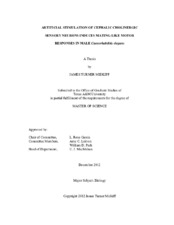| dc.description.abstract | All complex organisms possess a nervous system which they use to monitor environmental and internal stimuli. In higher vertebrates, the nervous system is comprised of billions of cells which form highly plastic neural networks from their synapses. These large neural circuits modulate complex behaviors. The nematode roundworm Caenorhabditis elegans uses a small but highly-interconnected nervous system to carry out complex behaviors. The nervous system of C. elegans is a tractable model to determine the effects of changes on a nervous system at the systemic, cellular, genetic, and molecular levels.
The C. elegans male’s nervous system detects environmental conditions, mating cues, attractants, repellents, and the location and composition of possible food sources and integrates these inputs to compute the decision of whether or not to mate. Mating behavior in the C. elegans male is regulated at a number of steps by cholinergic signaling from various sensory and sensory-motor neurons, but a comprehensive model of how cholinergic signaling controls this circuit has not yet been elucidated. Previous studies have thoroughly dissected the cellular structure, neural connectivity, and signaling pathways of the male’s peripheral circuits located in the genital regions of the animal’s tail. However, no studies have been conducted to determine what role the cephalic cholinergic neurons have in regulating mating behavior.
I hypothesized that cephalic cholinergic neurons exert regulatory control over the male-specific mating circuit. I inserted the transmembrane light-activated ion pore Channelrhodopsin-2 fused to YFP and expressed from the Punc-17small promoter into these neurons and selectively stimulated them using high-intensity blue light. Stimulation induced mating-like behaviors in the male tail consistent with behaviors seen during copulation with a hermaphrodite. Using behavioral assays, I demonstrated that these behaviors were male-specific and only occurred after direct stimulation in the absence of a hermaphrodite. Incidence of mating-like behaviors increased significantly as the worm aged, and the mating circuit retained a memory of the stimulus, indicated by the latency between stimulation and onset of mating-like behaviors. Brief food deprivation, which normally downregulates excitability of the mating circuit via UNC-103 ERG-like K+ channels, caused an unexpected increase in the number of blue light-stimulated behaviors displayed. Pharmacological assays using acetylcholine (ACh) agonists showed that stimulation of the cephalic cholinergic neurons increased propensity for spicule protraction in the presence of an ACh agonist, and partially restored the decline in spicule protraction associated with temporary food deprivation.
I sought to identify the cephalic cholinergic neuron or neurons responsible for regulating mating-like behavior in the tail circuits. I looked for a reduction in mating-like behaviors after stimulation after removal of a cephalic cholinergic neuron pair via laser micro-ablation. Two cholinergic and chemosensory neuron pairs in the inner labial sensilla (IL2L/R and IL2VL/R) appear to generate and/or relay the signal that induces mating-like behaviors in the tail. I hypothesize that these neurons sense environmental cues before the male contacts a mate, and modulate lasting motivational changes within the male mating circuit. | en |


